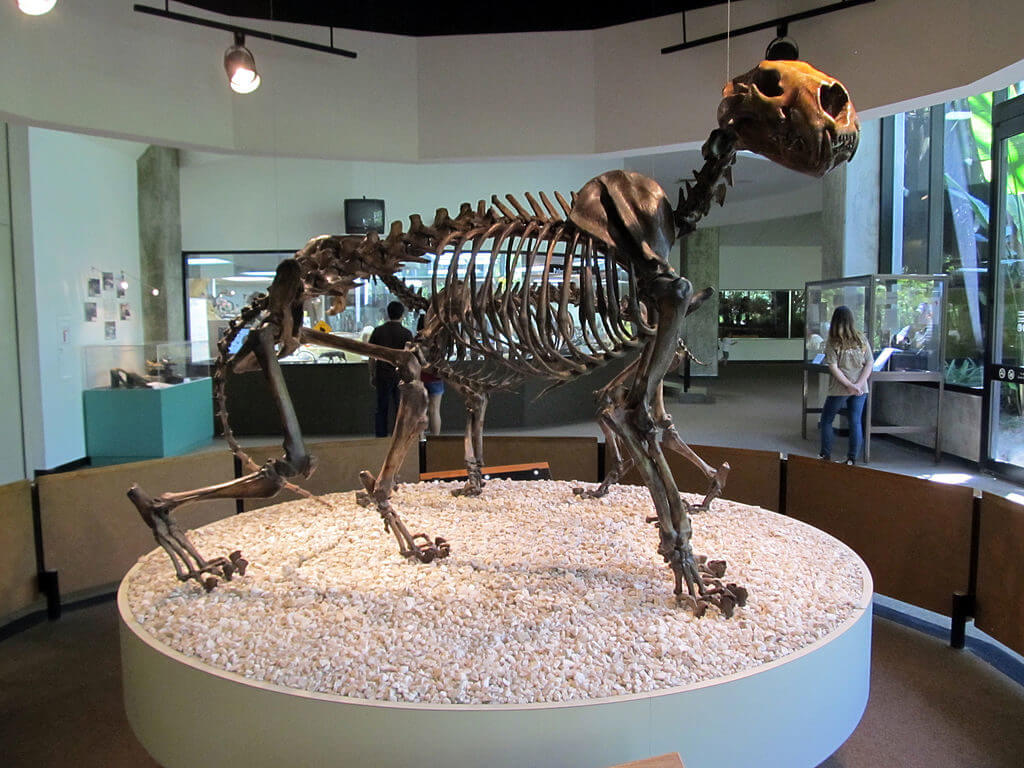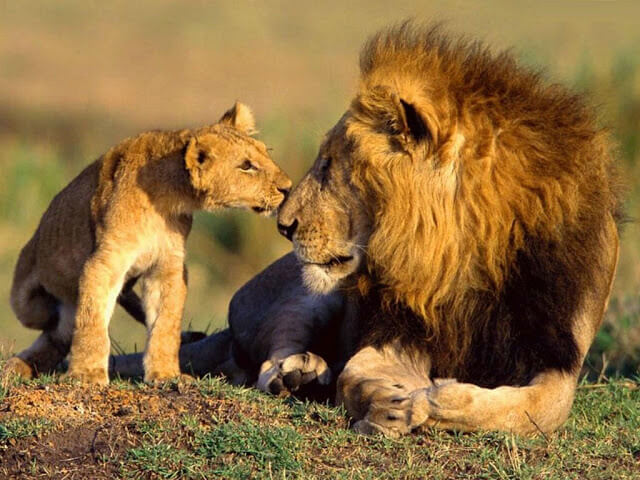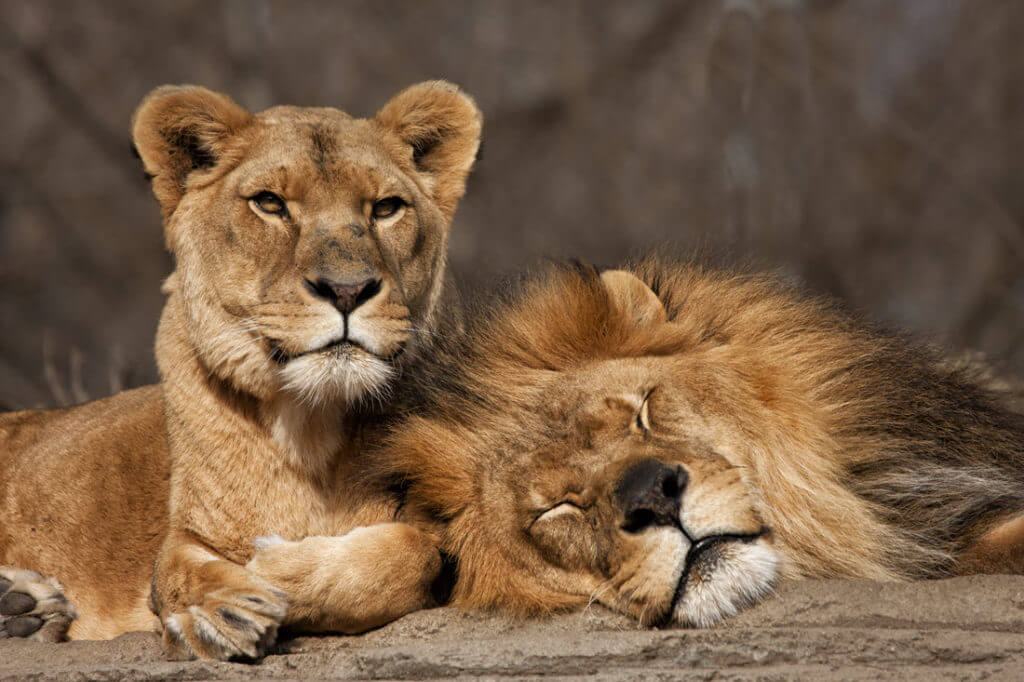The lion has lived on this planet for over a million years, and are the second largest wild cat after the tiger. They are a symbol of power, strength and courage. Most lions live in Africa. There is also a small population of lions called the Asiatic Lion that lives in India.
Scientific Name: Panthera leo
Conservation Status: Vulnerable
Subspecies: The lion is one of the five big cats in the genus Panthera, which also includes the tiger, jaguar, leopard and snow leopard. For a long time it was believed that there were several lion subspecies. As of 2017 only two subspecies are now recognized:
Panthera leo leo – includes lion populations in West Africa and northern parts of Central Africa. Also the Asiatic lion, and others previously listed as subspecies: the West African lion (Panthera l. senegalensis), Panther l. kamptzi and Panther l. azandica.
Panthera leo melanochaita – includes lion populations in Southern Africa and East Africa and the extinct Cape lion.
Interesting facts about lions
- The second biggest wild cat.
- Males have a brown mane.
- Lions rest up to 20 hours a day.
- One of the most well-known animals on the planet.
- They live in groups (prides) of 10 to 15 lions.
- The roar of a male lion can be heard up to five miles away.
- Females do most of the hunting, while males defend their territory.
More about lions
History
Today, most of the world’s lion population lives in Africa, but 50,000 years ago they were prevalent in the Middle East, Southern and Central Europe and India not to mention north and east through Asia as far away as Siberia. Most likely the cats went north out of Africa into Europe and Asia eventually crossing the Bering land bridge into Alaska and down through North America to Mexico. They were an integral part of the planet’s ecosystems occupying more territory than any other mammal in history, second only to that of Man, himself, whose subsequent flourishing contributed to the loss of habitat and diminished range of the lion, right on up to the present day.
The cave lion
A molecular study of ancient fossils suggests the Panthera species could have begun as long ago as 2 to 3 million years but the clearest and most abundant fossilized evidence dates from Europe, Siberia and Alaska about 500,000 years ago where the enormous Cave Lion (Panthera leo fossilis) roamed. The Cave Lion is a quarter larger than today’s lions, and had a territory of immense proportions. Since then it evolved into what is known as the true Cave Lion (Panthera leo spelaea) which, during the last 60,000 years, became extinct, probably due to a combination of climate change and over-hunting by humans.
The American lion
 The American lion (Panthera leo atrox) lived in Central America and as far as Peru, half way down the South American continent. It is thought to be the largest lion to have ever lived, standing five feet tall and measuring 11½ feet from nose to tail. It weighed in at about 700 to 800 pounds. This big cat’s brain to body size was larger than any known modern cats.
The American lion (Panthera leo atrox) lived in Central America and as far as Peru, half way down the South American continent. It is thought to be the largest lion to have ever lived, standing five feet tall and measuring 11½ feet from nose to tail. It weighed in at about 700 to 800 pounds. This big cat’s brain to body size was larger than any known modern cats.
The American lion was stronger and probably faster than any other cat and in its time was a competing predator with saber-tooth cats. It could bite twice as strong as today’s lion. More than 100 American lions have been found at the La Brea Tar Pits in Los Angeles, CA.
About 13,000 years ago, however, it went extinct, most likely following the extinction of its prey.
Physical appearance

Key conservation issues
Lions once roamed in large numbers throughout Africa. Even 50 years ago there were more than 200,000 lions living in the wild, Today, their numbers have been drastically reduced to less than 15,000 lions. Like most wild cats, lion populations are are rapidly downtrending due to habitat loss, illegal trade, poaching, hunting, retaliation killing and loss of prey.
Many areas where lions once roamed have become farm or cattle lands. Not only are they losing their habitat, they are also becoming sick from diseases (canine distemper virus, bovine tuberculosis and Feline Immunodeficiency Virus) that impact their immune system and ability to reproduce.
There are many African countries that prohibit lion hunting, but trophy hunting is still permitted in Burkina Faso, Cameroon, CAR, Mozambique, South Africa, Nambia, Benin, Tanzania, Zimbabwe and Zambia. Hundreds of lion “trophies” continue to be exported each year.
Lions are also being breed in captivity and killed to provide skins and other types of lion products.
Find lion conservation organizations…


We need to do more to save our big and small cat populations! It would be so sad to see a lot of these beautiful animals go extinct.
love it with the facts
I like lion so much a lot more
Hi Andy, We agree! Spreading the word is important…
Best,
D.R.
I think there should be more shows like Big Cat Diary and conservation efforts like in the show Lion Country. I think these ideas would spread the word, especially to young kids that watch Animal Planet before and after school. I think this would be a good for the up incoming youth. (: